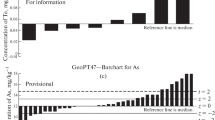Summary
Lead is a trace element of major interest in biological materials, human food and animal feeding stuffs. There is an especially high risk of contamination during the analysis, which will result in high and strongly fluctuating blank values. The contribution of the blank to the analytical result is one of the main parameters determining the detection limit.
The influence of a number of common procedures on the blank value has been studied. These procedures include various digestion and measuring methods, viz. wet digestion by “classical” methods; Teflon bomb destructions; dry-ashing in a muffle furnace with a chamotte or silica chamber; mineralization with a “Tecator” device; low-temperature plasma ashing; further chemical treatment and measurement by flame or electrothermal AAS or by differential pulse anodic stripping voltammetry. The limits of detection resulting from the blanks in these methods have been tabulated. The sources of contributions to the blank values and the risks of ignoring them have also been demonstrated.
Zusammenfassung
Blei findet als Spurenbeimengung in biologischem Material, Nahrungsstoffen und Futtermitteln besonderes Interesse. Deren Analyse unterliegt in hohem Maß der Gefahr einer Einschleppung, die dann zu hohe und stark fluktuierende Blindwerte zur Folge hat. Diese Blindwerte sind ein wesentlicher Parameter bei der Bestimmung der Nachweisgrenze. Der Einfluß einer Reihe gewöhnlicher Arbeitsweisen auf den Blindwert wurde untersucht. Diese sind verschiedene Veraschungsmethoden, Meßmethoden, z. B. „klassische“ nasse Veraschung; Teflon-Bomben-Veraschung; trockene Veraschung in einem Muffelofen mit Chamotte- oder Silikatauskleidung; Mineralisierung mit einem „Tecator“; Tief-Temperatur-Plasma-Veraschung; anschließende chemische Verarbeitung und Messung durch Flammen- oder elektrothermale AAS bzw. durch differentielle „Pulse-anodic-stripping-voltammetry“. Die Nachweisgrenzen für diese Methoden wurden angegeben. Ebenso wurden die Ursachen einer Erhöhung der Blindwerte und die Risken bei deren Nichtbeachtung aufgezeigt.
Similar content being viewed by others
References
R. Neeb, Polarographische Analysenverfahren, Labo, Teil I, pp. 1037–1066; Teil II, pp. 1310–1325, 1974.
A. F. Ward and H. R. Sohel, Trace Elements in Environmental and Biological Samples Using ICAP-OES, 3rd Annual FACCS Meeting, Philadelphia. 1976.
IUPAC, Nomenclature, Symbols, Units and their Usage in Spectro-chemical Analysis-II, Analyt. Chemistry48, 2294 (1976).
Author information
Authors and Affiliations
Rights and permissions
About this article
Cite this article
de Ruig, W.G. Experiences with various methods of trace analysis in organic matrices, with special reference to lead blank values. Mikrochim Acta 76, 199–206 (1981). https://doi.org/10.1007/BF01196736
Received:
Issue Date:
DOI: https://doi.org/10.1007/BF01196736




